If you want to bring a new dynamic to your garden, then try planting pampas grass. This ornamental grass is popular in American gardens, even though it’s technically an invasive species.
Pampas grass produces thousands of seeds at the end of the growing season, and strong winds can carry the seeds over lengthy distances. Pampas grass germinates in a variety of climate conditions, and almost any soil mixture.
Once pampas grass establishes itself, it can take over the area within a season. However, prudent gardeners can keep pampas grass under control with some end-of-season maintenance. Both South Carolina and California list pampas grass as an invasive species, and it’s also in the global invasive-species database.
Pampas Grass Quick Facts
| Quick Facts | Information |
|---|---|
| Invasiveness | Pampas grass is invasive and can take over the area within a season. Listed as an invasive species in South Carolina, California, and the global invasive-species database. |
| Growing Conditions | Pampas grass thrives in sunny growing sites with fertile soil. |
| Starting from Seed | Sow seeds in early spring, in a spot that receives direct sunlight. Do not cover seeds with soil. |
| Planting Site | Choose a location with full sunlight and ample space for the grass to grow tall and wide. Avoid planting near driveways, roads, air-conditioning units, or children’s play areas. |
| Transplanting | Dig a hole the width and height of the root system, add mulch or fertilized potting soil, and water thoroughly after transplanting. |
| Watering | Water newly planted grass thoroughly and keep the soil uniformly moist. |
| Fertilizing | Fertilize in early spring, early summer, and the beginning of fall during the first year. After the first year, fertilize only in early spring. |
| Dividing Pampas Grass | Propagate in late August to early September or in early spring after the last frosts. |
| Pests and Diseases | Pampas grass is resistant to most pests and diseases but can experience fungal infections. Treat with a general plant fungicide if necessary. |
| Overwintering | Cut back old foliage and flower stalks in late fall. Spread mulch around the base and cover with burlap in colder regions. Remove burlap in early spring. |
| Ornamental Use | Pampas grass is popular for its ornamental plumes, privacy screening, and use in beach-front landscapes. |
Growing Pampas Grass
Still, pampas grass is beautiful and complements other plants in your garden. The grass also makes a fantastic filler for areas of the garden that look sparse, such as around the pool or the corners of your yard.
All your pampas grass needs to thrive, is a sunny growing site, with fertile soil. We outlined a brief growing guide for pampas grass to give you an idea of the techniques used to manage these grasses in your yard.
It’s crucial for you to plant your grass in the early spring, as planting in the fall or winter may impede its growth the following summer season.
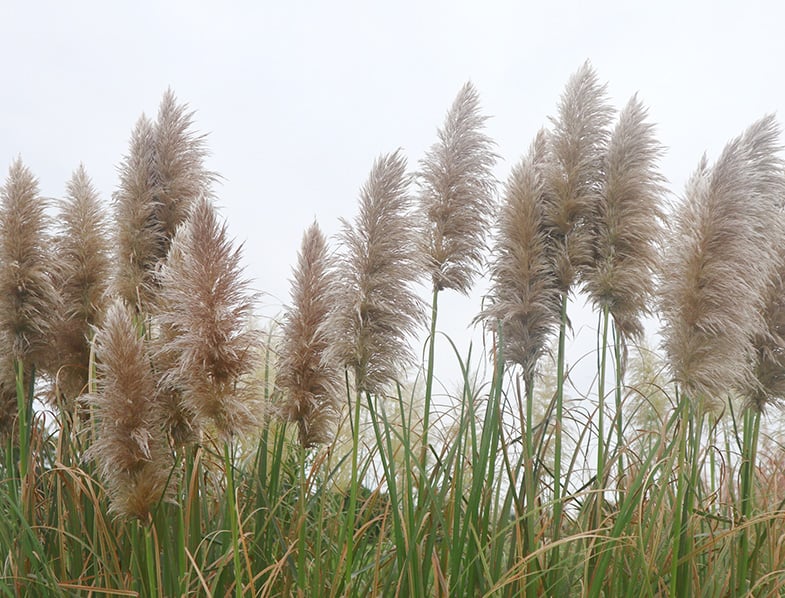
Starting with Seed
Unlike most other plants, growing pampas grass from seed is easy. All you need to do is select your variety, and then sow your seeds in the early springtime. Pick a spot in your yard that receives direct sunlight all day, and sow your seeds.
Don’t cover the seeds with soil, as the heat from the sunlight and a light watering are all the seeds need to germinate. We suggest that you give the soil a light raking before you sow your seeding. Raking the ground loosens the soil, providing aeration to the roots of the grass, allowing it to thrive.
However, if you live in an area with plenty of birds, you’ll need to cover the planting area with netting to stop the birds from eating your seeds. If you don’t have any netting, then you can start your seeds in pots or trays indoors and then transplant to the garden after it gets to an inch in height.
Starting your seeds indoors is also a good idea if you live in colder regions of the United States. Mix up a growing medium using sol and perlite in a 2:1 ratio.
By adding perlite to the soil, you get better drainage. Always ensure that your container has adequate drainage, and wet soil may cause root rot in your grass.
- Pampas grass is ornamental. Fresh green foliage reaches 8 to 12 feet tall, topped by long, thick silky "featherdusters"
- Pampas ornamental grass grows fairly fast making it an ideal choice for filling in large, barren landscapes
- It will grow in most soils with hardly any work. Low to no maintenance. You can shear ornamental grasses each winter so that new growth comes out clean in Spring
- Cortaderia selloana Pampas Grass has long, graceful blades and fluffy panicles that are beautiful
- Pampas Grass for wind protection and disguising unwanted scenery
- 100 Pcs Pink Pampas Grass Seeds
- White pampas grass is an ornamental which grows as a perennial in USDA Zones 7 - 10. Fresh green foliage reaches 8 to 12 feet tall, topped by long, thick silky-white "featherdusters" that bloom in late-summer and last for months!
- Pampas ornamental grass grows fairly fast, so is an ideal choice for filling in large, barren landscapes. It will also grow thick creating an effective privacy screen, wind break or sound barrier.
- Pampas ornamental grass grows fairly fast making it an ideal choice for filling in large, barren landscapes. Its long, graceful blades and delightfully fluffy pannicles (flower plumes) are beautiful. Unsurpassed for glorious texture and color in the landscape, this classic White Pampas Grass (Cortaderia Selloana) is the star of any garden it graces!
- It is also highly drought-resistant and, once established, never needs watering. It will grow in most soils with hardly any work. Low to no maintenance. You can shear ornamental grasses each winter so that new growth comes out clean in Spring. You can do this every other year or less often if you like.
- Sow 5 seeds per plant to begin growing cortaderia white pampas grass plants.
Last update on 2024-09-22 / Affiliate links / Images from Amazon Product Advertising API
Choosing the Right Planting Site for Your Pampas Grass
When selecting the ideal spot in your yard for your pampas grass, you need to take into account the final height and width of the grass flowerbed you plant. Pampas grass grows wide and tall, and if you don’t account for the growth, it could result in the area looking cluttered.
Select an area of your yard that receives full sunlight throughout the day. Planting in shady areas is possible with pampas grass, but you need to be aware that the lack of sunlight will affect the final height of the grass, and some species might not flower without direct sunlight all day.
Avoid planting your pampas grass next to the driveway or the road. This grass grows tall and wide, and it may obstruct your view of the road and the driver’s view of your driveway. Don’t plant the grass near any air-conditioning units, as the blades of grass might end up caught in the machines fan.
Make sure that you keep the grass away for any areas of the yard where children play. Pampas grass looks beautiful when flowering, but the leaves have razor-sharp edges, and children might cut themselves if they try to pull on the grass or fall into the grass by mistake.
If you’re transplanting pampas grass, then dig a hole that’s the width and height of the plant’s root system. Place some mulch or fertilized potting soil in the hole, and then add the grass. Pampas grass doesn’t need lots of fertilizer to grow tall and healthy.
Use your hands to separate the root ball before planting, and gently pat down the soil around the roots after planting. Water the grass thoroughly to reduce transplant shock.
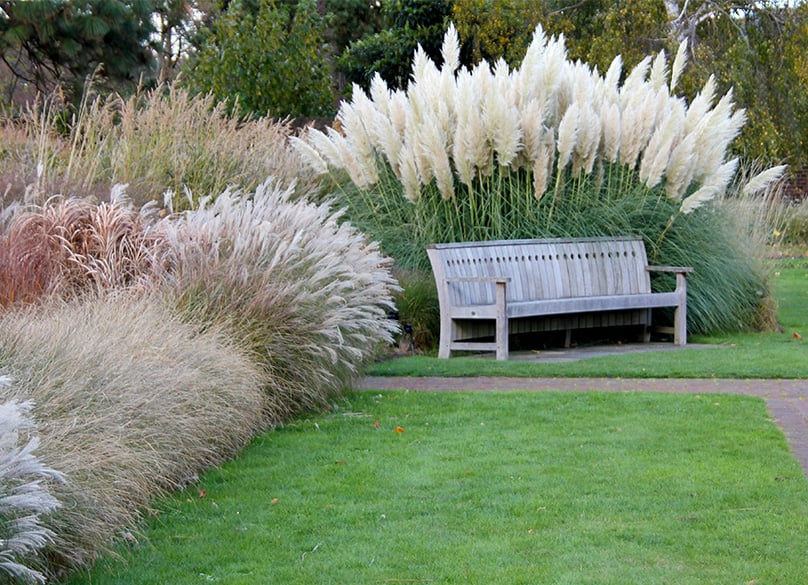
Caring for Your Pampas Grass
Always water your newly planted grass thoroughly after transplanting. The roots require plenty of moisture to recover from the stress of the transplant. Failing to water your pampas grass could stunt its growth, or cause it to die.
Ensure that you keep the soil uniformly moist. Push your finger an inch into the soil. If it feels moist, then your grass is fine. However, if it’s dry, it means that the roots aren’t getting the moisture they need.
During the first year after planting, fertilize your grass in the early spring, early summer, and at the beginning of the fall. After the first year of growth, cut back on your fertilizing protocol, and only fertilize the grass in the early spring.
It might take up to 3-years for your grass to establish itself and bloom. Every year, you’ll need to prune away old grass and trim the roots of grasses that are becoming wild and overgrowing in the planting site.
Dividing Pampas Grass
You can propagate your pampas grass in late August to early September before the winter rolls around. However, we recommend that you do your propagation in the early springtime, after the last frosts land on the ground. Check your local listing for frost dates in your area and plan accordingly.
Propagating in the early spring gives the pampas grass the entire growing season to grow a strong root system. Follow these steps when propagating your pampas grass.
- Cut the grass back to 1 to 2-feet in length until you can see the base of the plant.
- Examine the stems of the grass at the soil level.
- You should see that shoots are forming at the base.
- Using a sharp knife, cut away the new growth from the middle of the plant.
- Plant your new grass clumps at a similar depth to what they were used to with the mother plant.
- Water thoroughly to reduce transplant shock.
- Always make sure you wear gloves and a shirt, as you might cut yourself on the sharp edges of the grass.

Pests and Diseases Affecting Pampas Grass
Pampas grass is an invasive species. Therefore, it does not serve as a food source for any animals like deer and rabbits. Many insects and birds like to nest in the grass, so be careful when propagating in the early springtime.
Pampas grass does occasionally experience an infection with a fungus that shows up as spots. This fungus typically arrives during warm and rainy parts of the season. Use a general plant fungicide to treat the infection and restore your pampas grass to health.
Ornamental and Decorative Purposes
Pampas grass is popular as it creates an ornamental feature in your garden. This decorative grass produces large plumes of flowers that look attractive. Pampas grass is ideal for planting in the western states, as the plant is hardy and drought-resistant.
If you live close to the ocean, pampas grass is ideal for planting around your yard, as the salty air doesn’t damage the grass. Many hotels and guesthouses on the beach use pampas grass as a windbreak and for beach-front landscapes.
Pampas grass grows anywhere from 6 to 13-foot tall, and it spreads to a width of the same height in most cases. Use this grass to create privacy around your patio or pool, and plant it in the corners of your yard to give your garden a seamless look and feel.
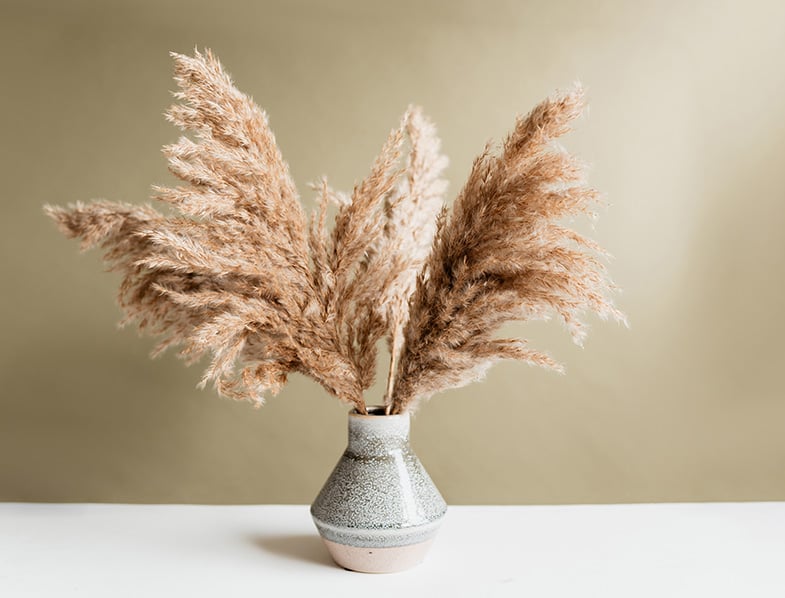
Overwintering Pampas Grass
Pampas grass can survive the cold months of winter, and even snowfall provided that you prepare it for the winter season.
During the last days of fall, cut back any old foliage to make room for new growth the following season. We recommend long-handle loopers for trimming your pampas grass. Make sure you remove all of the flower stalks that are blooming, as the seeds may spread into your neighbor’s yard and start to grow wild.
Remove any stalks that are over 1-foot in height. Before you trim, use string to tie the plant together. This process helps to drain any excess water from the plant before cutting. If you live in a region of the United States, then you can overwinter your pampas grass without any hassle.
Spread mulch around the base of the plant and cover it with burlap to provide the grass with protection from the cold. Remove the burlap in the early springtime after the last frosts fall. Using this method, the roots of your pampas grass stay warm and dry during the wintertime, ensuring that your plant survives the season and thrives the following summer.
Varieties of Pampas Grass
Here are some popular varieties of pampas grass:
- Cortaderia selloana ‘Pumila’: This dwarf variety of pampas grass is perfect for small gardens or areas with limited space. It grows to a height of 4-6 feet and a width of 3-4 feet, producing silvery-white plumes in late summer and early fall. ‘Pumila’ is a more compact option that still provides an impressive display.
- Cortaderia selloana ‘Sunningdale Silver’: This variety is known for its tall, arching stems that can reach up to 10-13 feet in height. The silvery-white plumes emerge in late summer and can last well into winter. ‘Sunningdale Silver’ is an excellent choice for creating a focal point in a landscape or for providing privacy.
- Cortaderia selloana ‘Pink Feather’: As the name suggests, this variety boasts stunning pink plumes that add a splash of color to any garden. ‘Pink Feather’ can grow up to 6-8 feet tall and 4-5 feet wide, making it a suitable option for medium-sized gardens or as a border plant.
- Cortaderia selloana ‘Rosea’: Another pink variety, ‘Rosea’ produces plumes with a soft rose hue, offering a more delicate and subtle color compared to ‘Pink Feather.’ This variety can reach up to 8-10 feet in height and 6 feet in width, making it a striking addition to any landscape.
- Cortaderia selloana ‘Patagonia’: This variety is known for its robust growth and thick, silver plumes. ‘Patagonia’ can grow up to 12-15 feet in height and 8-10 feet in width, making it ideal for creating a strong visual impact or for use as a windbreak.
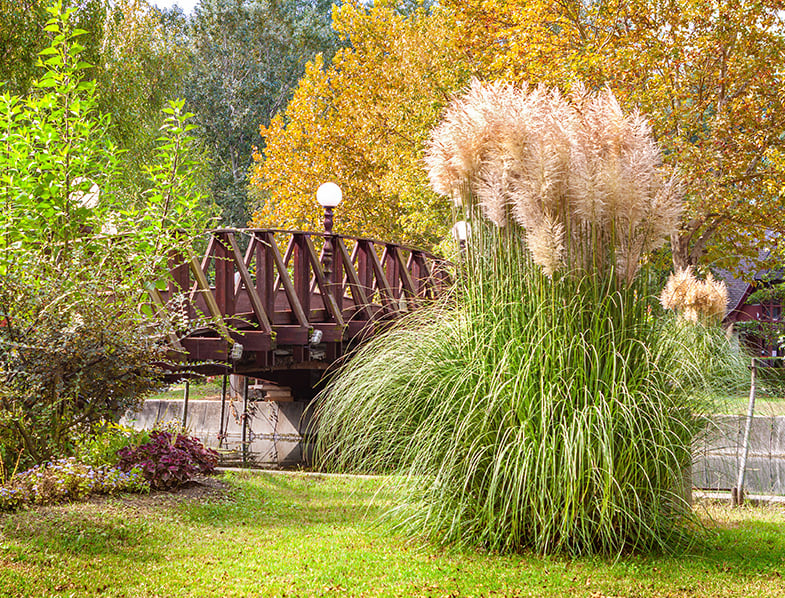
Alternatives to Pampas Grass
Here are some alternatives to pampas grass that you can consider for your garden:
- Maiden Grass (Miscanthus sinensis): This ornamental grass has a similar appearance to pampas grass but is more manageable and less invasive. Maiden grass comes in various cultivars, offering different sizes and colors, and features elegant plumes that emerge in late summer.
- Feather Reed Grass (Calamagrostis x acutiflora): Feather reed grass is a clump-forming, non-invasive ornamental grass that can reach heights of 3-5 feet. It produces feathery, purplish-green plumes in early summer, which turn golden brown as the season progresses.
- Fountain Grass (Pennisetum alopecuroides): Fountain grass is known for its graceful, arching habit and bottlebrush-like plumes that appear in late summer. This perennial grass can grow up to 3-5 feet tall and is available in various cultivars, including the popular ‘Hameln,’ which is a more compact variety.
- Switchgrass (Panicum virgatum): Native to North America, switchgrass is a tall, upright grass that can reach heights of 4-6 feet. It features airy, reddish-pink plumes in late summer and boasts impressive fall color in shades of yellow, orange, and red. Switchgrass is also drought-tolerant and adaptable to a variety of soil conditions.
- Little Bluestem (Schizachyrium scoparium): This native grass is ideal for those seeking a smaller, more compact option. Little bluestem typically grows to a height of 2-4 feet and features stunning blue-green foliage that turns coppery-red in the fall. This grass is drought-tolerant and perfect for naturalistic or prairie-style gardens.
- Purple Moor Grass (Molinia caerulea): Purple moor grass is a clump-forming perennial that grows up to 3-5 feet tall. It produces delicate, purplish-green flower spikes that emerge in late summer and turn a golden brown color in the fall. This grass is suitable for mixed borders and provides an elegant, wispy appearance in the garden.
- Blue Oat Grass (Helictotrichon sempervirens): With its striking blue-gray foliage, blue oat grass offers a unique color contrast in the garden. This evergreen ornamental grass can reach heights of 2-3 feet and produces tall, oat-like seed heads in early summer. Blue oat grass is drought-tolerant and works well in rock gardens or as a border plant.
When selecting an alternative to pampas grass, consider the specific needs and conditions of your garden, such as available space, sunlight, and soil type. Many of these alternatives are non-invasive, easier to manage, and offer similar visual appeal to pampas grass while being more environmentally friendly.
Conclusion
Pampas grass is a beautiful and popular ornamental grass that can add a stunning dynamic to your garden.
Despite its invasive nature, with proper management and maintenance, it can be controlled and complement other plants in your garden. By following the guidelines outlined in this article, you can grow and care for pampas grass effectively.
Keep in mind the importance of selecting the right planting site, providing proper care, and being mindful of potential pests and diseases. With its attractive plumes and ability to create privacy, pampas grass can be a striking addition to your landscape, especially in coastal areas where it thrives in the salty air.
Pampas Grass FAQs
Is pampas grass easy to grow?
Yes, pampas grass is relatively easy to grow, as it can germinate in a variety of climate conditions and almost any soil mixture. Just ensure you provide it with full sunlight and fertile soil.
Is pampas grass a good idea?
Pampas grass can be a good idea for adding an ornamental feature to your garden, as it provides a dramatic look with its tall plumes. However, it is considered invasive, so proper care and maintenance are essential to keep it under control.
Does pampas grass come back every year?
Yes, pampas grass is a perennial plant, which means it comes back every year. It may take up to three years for the grass to establish itself and bloom fully.
Can pampas grass survive winter?
Yes, pampas grass can survive winter, especially if you take proper measures to protect it from the cold. Cut back the foliage and cover the base of the plant with mulch and burlap to help it withstand the winter months.
How long will pampas grass last?
Pampas grass is a long-lived plant and can last for many years if properly cared for. With appropriate maintenance, it can continue to grow and produce its characteristic plumes year after year.
What are the negative effects of pampas grass?
The primary negative effect of pampas grass is its invasive nature, which means it can spread quickly and take over an area if not managed properly. It’s listed as an invasive species in some regions, so it’s essential to keep it under control. Additionally, the leaves have razor-sharp edges, which can be hazardous, especially for children.
Is pampas grass toxic to humans?
Pampas grass is not considered toxic to humans. However, the sharp edges of its leaves can cause cuts and scratches if not handled carefully. It’s essential to wear gloves and protective clothing when working with pampas grass to avoid injury.


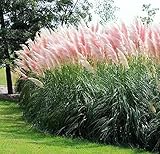
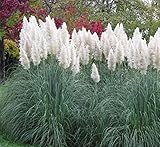
12 Comments
I need to see what a sprout of pampas grass looks like please
I live in Florida can I just throw seeds down and cover it with miracle grow or do I have to start seeds indoors
I have a large dead area in the centre of my plant . It gets bigger each year and doesn’t seem to want to regenerate. Why?
Do you live in a wet climate? If so the center of the plant is rotting. Start by pulling out the large old stalks in the center of the plant.
Are they mushy and ? Keep pulling.
If a wet climate don’t trim in the fall but rather late spring. Trimming in fall can induce more rot as rain water enters the cut ends.
Some places require tenting the top with plastic during the rainy season.
A good dose of 16-16-16 fertilizer in early spring would help also.
I, too, would like to see what a sprout of pampas grass looks like please. I purchased some seeds online and planted them in pots. But now, 4 months later, it looks like overgrown field grass that spreads out more than it stands up.
My pampas grass has started to turn to straw about 15cms from the ends….whats happening ? Or is this normal for September ?
My grass has become too large for my landscaping. Is it good to trim them back from the sides and can I transplant those?
Hi can anyone please tell me where I find the seeds for next year on my plant .is it the fluffy plumes or a special one if so what time of year would I see this. Thank you
i planted a pampas grass 2 yrs ago the first yr it grew to about 4 ft 1cut it right down to abot 10inch in april this yr it is now about 6 ft with one 7 ft plume is this normal thank you ken
We cut the Pampas back to base close to grown. Only shoots to sides no grown in middle, is there any way of saving this pampas and if we have to take out how deep are the roots.
how long the the pampas grass blooms the beautiful color on top?
Do you just cover the base with burlap or the whole plant for winter